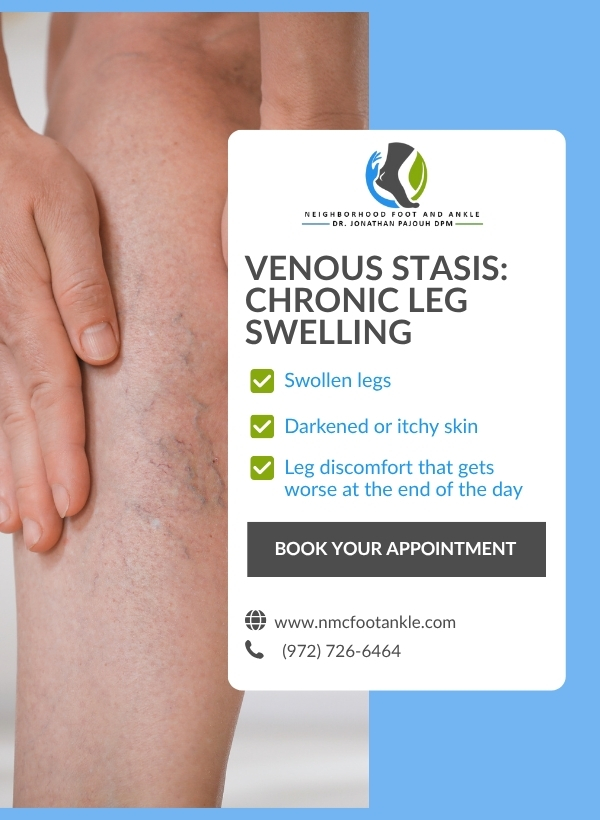
Did you know that chronic leg swelling could be a telltale sign of venous stasis? This serious condition, often overlooked, manifests as tired, achy legs and can lead to severe complications if not treated promptly. Recognizing the symptoms is crucial for preservation of your leg health and overall quality of life. In this post, we will delve into the causes, symptoms, and treatment options for venous stasis, empowering you to take charge of your condition and ensuring you receive the expert foot and ankle care you need.
Understanding Venous Stasis
Venous stasis refers to the inadequate blood flow in the veins of the lower legs, leading to blood pooling. It is essential to grasp how this condition develops to better address its implications. The veins are responsible for returning blood to the heart, aided by valves that prevent backflow. When these valves fail, blood can accumulate, particularly in the legs. Poor circulation can arise from various factors including obesity, inactivity, prolonged standing, and age.
Symptoms Of Venous Stasis
Chronic leg swelling is often the first symptom that draws attention. The symptoms can escalate if not addressed early:
- Swelling: The most prominent issue; legs may feel heavy.
- Skin Changes: Discoloration might appear, indicating potential underlying issues.
- Itchiness: The skin may become dry and irritated.
- Leg Ulcers: In some cases, open sores can develop due to prolonged stasis.
Risk Factors
Several factors may increase one's likelihood of developing venous stasis, including:
1. Age: Aging can diminish vein elasticity.
2. Obesity: Extra weight can exert pressure on veins.
3. Sedentary Lifestyle: Lack of movement hinders circulation.
4. Occupational Factors: Jobs that require prolonged standing or sitting can exacerbate this condition.
5. Genetics: Family history of vein issues may predispose you to venous stasis.
How to Diagnose Venous Stasis
If you suspect that you have venous stasis, a qualified medical professional, such as a podiatrist, can provide a thorough assessment. Commonly used diagnostic methods include:
- Physical Examination: Visual inspection of legs and discussion of symptoms.
- Ultrasound: This imaging technique helps visualize blood flow in the veins, confirming if there are blockages or defects.
Treatment Options
Treatment will vary based on the severity of the condition, but here are common methods utilized to alleviate the symptoms and improve overall leg health:
Conservative Treatments:
- Compression Therapy: Wearing compression stockings can significantly reduce swelling and promote circulation by applying controlled pressure to the legs.
- Lifestyle Changes: Adopting a healthier diet, engaging in regular physical activity, and maintaining a healthy weight can mitigate symptoms.
- Medications: Anti-inflammatory medications can help alleviate discomfort associated with leg swelling.
Advanced Interventions:
- Sclerotherapy: This minimally invasive procedure involves injecting a solution into affected veins, causing them to close.
- Endovenous Laser Treatment: A laser treatment that minimizes veins also helps to reduce pool blood effectively.
- Surgery: In severe cases, surgical options are available to remove or bypass problematic veins.
Preventative Measures
Preventing venous stasis boils down to maintaining healthy circulation:
- Stay Active: Regular, moderate physical activity can help enhance blood flow.
- Elevate Your Legs: Raising your legs while resting can assist in reducing swelling.
- Avoid Prolonged Stationary Positions: Whether sitting or standing, taking breaks to move around is crucial.
When to Seek Medical Help
Do not dismiss persistent leg swelling or discomfort. Consult a healthcare provider, such as Dr. Pajouh, if you experience any of the following:
- Swelling that lasts for more than a week or worsens over time.
- Pain or tenderness in the legs, especially if accompanied by swelling.
- Skin changes such as discoloration or ulcers.
Conclusion: Where to Go from Here?
Understanding chronic leg swelling and its implications plays a significant role in managing venous stasis effectively. By recognizing the symptoms early and seeking appropriate treatment, you can prevent serious complications and improve your leg health.
Prioritize your health today! Remember, taking charge of your symptoms is the first step towards healthier legs and a more active lifestyle. You don’t have to live with swollen legs—action is the remedy.
Schedule Your Appointment:
Contact Us – Reconstructive Podiatric Foot & Ankle Surgeon, Dallas TX
